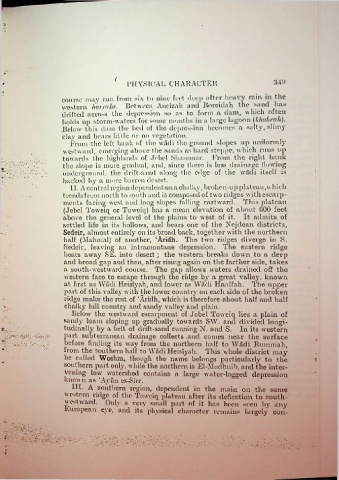Page 344 - A Hand book of Arabia Vol 1 (iii) Ch 6 -10
P. 344
:un
' PHYSICAL CHARACTER
r
course may run from six to nine feet deep after heavy rain in the
western hurrahs. Between Ancizah and Iiorcidah the sand has
drifted across the depression so as to form a dam, which often
holds up storm-waters for some months in a large lagoon (khubrcili).
Below this dam the bed of the depression becomes a salty, slimy
clay and bears little or no vegetation.
From the left bank of the wadi the ground slopes up uniformly
westward, emerging above the sands as hard steppe, which runs up
towards the highlands of Jebel Shammar. From the right bank
the slope is more gradual, and, since there is less drainage (lowing
s_
underground, the drift-sand along the edge of the wadi itself is
hacked by a more barren desert.
II. A central region dependent on a chalky, broken-up plateau,which
trendsfrom north to south and is composed of two ridges with escarp
ments facing west and long slopes falling eastward. This plateau
(Jebel Toweiq or Tuweiq) has a mean elevation of about GOO feet
above the general level of the plains to west of it. It admits of
settled life in its hollows, and bears one of the Ncjdcan districts,
Sedeir, almost entirely on its broad back, together with the northern
half (Mahmal) of another, ‘Aridh. The two ridges diverge in S.
Sedeir, leaving an intramontane depression. The eastern ridge
bears away SE. into desert ; the western breaks down to a deep
and broad gap and then, after rising again on the farther side, takes
a south-westward course. The gap allows waters drained off the
western face to escape through the ridge by a great valley, known
at first as Wadi Heislyah, and lower as Wacli Hanlfah. The upper
part of this valley with the lower country on each side of the broken
ridge make the rest of ‘Aridh, which is therefore about half and half
chalky hill country and sandy valley and plain.
Below the westward escarpment of Jebel Toweiq lies a plain of
sand}’ loam sloping up gradually towards SW. and divided longi
tudinally by a belt of drift-sand running N. and S. In its western
part subterranean drainage collects .and comes near the surface
*r-
before finding its way from the northern half to Wadi Rummah,
from the southern half to Wadi Heislyah. This whole district may
be called Woshm, though the name belongs particularly to the
southern part only, while the northern is El-Mudhnib, and the inter
vening low watershed contains a large water-logged depression
known as *Ayun es-Sirr.
III. A southern region, dependent in the main on the same
Western ridge of the Toweiq plateau after its deflection to south-
uc^tward. Only a very small part of it has been seen by any
European eye, and its physical character remains largely con-
: ........
" ••

